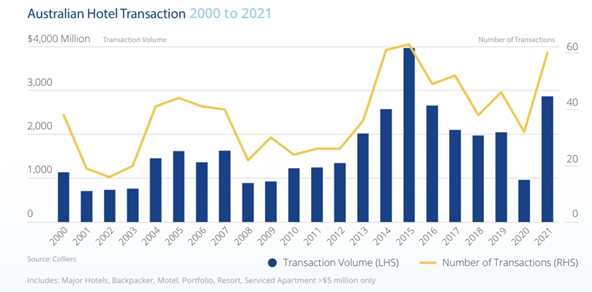- Over the last decade, we have searched for subsectors cyclically out of favour with traditional lenders.
- Lending at modest loan to valuation ratios generally means our facility balance is well below replacement cost, however, the backward-looking nature of the Australian loan market has resulted in low competition and good returns when offering capital to these dislocated subsectors.
- This has included apartment developments in Perth in 2017/18 and the Office sector at the onset of Covid in early 2020.
- We currently see the opportunity for standalone hotels in prime locations of Melbourne in anticipation of the reopening trade in 2022 and beyond.
Australia’s hotels have emerged from 18 months of demanding lockdowns with an intent to rebuild business momentum. Visitor rates are steadily climbing, cross-border business travel is resurging and there is increased hotel transaction activity. Hotel investors appear to be taking a long-term view of CBD hospitality real estate performance, buoyed by signs of stabilisation in the sector.
2021 transaction volumes were well above the long-term average reflecting a restart to the market following low sales activity in 2020 when investors were adopting a ‘wait and see’ approach. Colliers data suggests $2.87 billion worth of assets transacted last year, the highest transaction volume since 2015. In a continuing theme, 2022 sales data has been strong, including the largest hotel sale in Australia’s history for $530m (Hilton Sydney).

Source: Colliers
Hotel occupancy has been steadily improving in recent months. In April 2022, hotel occupancy rates in Melbourne were at 65.1% for the month (compared to 80%+ in most other regional markets), the highest since February 2020 according to STR. This is an improvement on the 2021 hotel occupancy rate of 33.9% (Colliers data). Average room rates are expected to recover to pre-pandemic levels more quickly than occupancy. In Melbourne, the Average Daily Rate (ADR) for April 2022 was $238 and Revenue per available room (RevPAR) was $155, the highest since November 2019.
Return to pre-pandemic occupancy levels is not likely for at least a year in Sydney and Melbourne. Compared with other capital cities in Australia, greater dependence on demand from international tourists and corporate travellers will be key factors impacting occupancy growth. The new supply coming into these markets is also an important consideration. According to Deloitte, of the likely 15,000 new rooms planned to be added to room stock across the top 11 markets in Australia over the coming years, 60% of potential developments will be in Melbourne, Gold Coast and Sydney.
Merricks Capital has closely tracked the opportunities and risks of lending into the hotel sector as the Covid-19 pandemic evolved and the associated government policy responses. Lending opportunities have been assessed on a project basis. Key areas of assessment include independent valuations which have reflected the disrupted environment for hotel operations, Hotel Management Agreements, asset location and competition, forecast occupancy, RevPAR, and overall quality of the project and sponsors. In general industry-wide assumptions are extremely conservative to account for the unknown.
Pre-pandemic (January 2020), Merricks Capital had three senior secured investments into hotel related assets, totalling $115m of deployed capital. As Covid-19 vaccines were developed and a path to reopening was evident, we opportunistically increased our exposure to this sector by targeting mixed-use developments with high levels of pre-sales of apartments which reduced investment risk. By April 2021, we had five senior loans with hotel exposure totalling approximately $215m. Since then, two of these loans have been repaid and today we have three investments totalling $185m or 8% across all our funds. All these loans have a clear path to repayment through pre-sales. For example, The Merricks Capital Partners Fund’s largest hotel exposure currently is $52m to a Sydney mixed-use development that will reach practical completion in the next month with a defined exit of the Hotel via pre-sale in the coming year.
With no pure-play hotel exposure in our portfolio and declining exposure in mixed-use projects, we have been seeking out ways to participate in the reopening trade in Melbourne. In our forward pipeline, there are two new potential investments both based in Victoria, which had the most severe lockdowns, and we are likely to settle a $105m new hotel investment in June. The scarcity of funding for hotel-related projects in capital cities has resulted in attractive loan opportunities with the key drivers of tourism and business travel returning underlying profitability to the sector.




